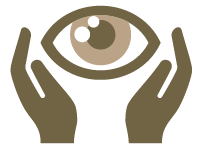
Therapeutic contact lenses are important tools for the treatment of ocular surface disease and other corneal conditions. Bandage contact lenses protect the cornea from environmental conditions and counter the abrasive effects of the patient’s own eyelids. Using these lenses can help repair tissue, manage pain, and maintain visual acuity. In this article, I outline five pearls for the appropriate use of these lenses.

Understand the indications for soft bandage contact lenses

PROTECTION
One important indication for therapeutic lenses is to protect the cornea in eyes with entropion, trichiasis, or exposed suture knots. For these conditions, soft bandage contact lenses should be considered a temporary measure until a structural solution is achieved.
For eyes with erosion of the ocular surface due to epithelial dystrophy or following ocular trauma, first-line therapy is nightly treatment with hypertonic drops and/or ointment before the patient sleeps. If this treatment is ineffective, however, a bandage contact lens should be applied before phototherapeutic keratectomy is considered. Bandage lenses must be used until the epithelial adhesion complex has fully recovered—at least 2 months. These lenses may also improve small irregularities of the ocular surface, which can in turn improve visual acuity.

PAIN RELIEF
Corneal erosion, bullous keratopathy, and filamentary keratitis can cause patients intense pain. The application of soft bandage contact lenses often provides measurable relief for patients who experience these conditions.
One should not apply bandage lenses in eyes with corneal erosion resulting from trauma, however, because the wound might be infected. In eyes that have previously undergone corneal abrasion for laser surgery or CXL treatment, one should consider the use of a bandage contact lens to manage pain and accelerate wound healing.
For many conditions, soft bandage contact lenses can help limit the acute pain that patients experience. A patient’s quality of life can be significantly improved through the use of therapeutic lenses.

HEALING
There are several conditions for which surgeons must actively encourage epithelial repair. These include neurotrophic keratitis, chemical burns, and after penetrating keratoplasty.
Neurotrophic keratitis is challenging to manage. Among the several therapeutic options at the physician’s disposal, bandage lenses have the advantage of preserving the patient’s visual acuity, visual field, and binocular vision.

SEALING
Bandage lenses can temporarily tamponade leaking wounds after cataract surgery. For small perforations, the lens may be effective in reshaping the anterior chamber, with or without the use of an adhesive. After glaucoma surgery, large-diameter bandage lenses can also help to manage excessive filtration.

Know the lens material before fitting
Two types of material are used in soft bandage contact lenses: hydroxyethyl methacrylate, which has been used since the 1970s, and silicone hydrogel polymers, available since 2000. Because of its high oxygen permeability, silicone hydrogel material is more compatible with the physiology of the cornea than its predecessors, so there is a reduced risk of hypoxia-related complications.
A number of silicone hydrogel lenses are available for day-and-night wear. Recently developed soft lenses have lower water content and are more resistant to dehydration.
Elastic modulus, a parameter that indicates the stiffness of a material, is an important element to consider. Lenses with a low modulus are flexible and can more effectively drape over the cornea. Stiffer lenses may be less comfortable for patients but are more effective at correcting optical irregularities.
The bandage contact lens should fit the patient tightly in order to prevent the lens from moving over the cornea and causing epithelial trauma. Typically one size fits all, but there are exceptions. In cases of an either unusually flat or steep cornea, a standard lens will not fit. In these cases, a custom bandage lens must be ordered.

Schedule frequent follow-up appointments
After applying a bandage lens, the first follow-up examination should occur 15 to 30 minutes after the fitting in order to assess how the lens fits and to obtain feedback from the patient. The second follow-up appointment should occur 1 day later, after the patient has had a full night of sleep wearing the lens. If no complications are seen, further appointments can take place at 1 week and 1 month. A common complication is loss of the lens due to dehydration of the lens or the patient’s eye rubbing. If this occurs, a custom soft lens that is larger in diameter can be used.
All patients with bandage contact lenses should use unpreserved tear drops to rehydrate the lens on the surface of the eye.
There is some discussion in the literature regarding the use of topical medications with bandage lenses, but the effectiveness of using lenses as a drug delivery method is unclear. More research is needed regarding the absorption and release of ophthalmic drugs through specific lens materials and designs.

Be aware of potential complications
A therapeutic lens is typically fitted to be worn day and night, depending on the nature of the disease. Continuous wear carries significant risk for developing infectious keratitis. Fortunately, for many conditions, bandage lens wear is temporary. However, if a condition requires that these lenses be worn over a long period, the physician should consider prescribing daily disposable contact lenses. Daily disposable lenses help prevent poor patient compliance and, therefore, mitigate the risk of infectious ulceration.
Use of topical antibiotic drops should be considered if the patient has an epithelial defect, but the patient must be informed about the warning signs of keratitis such as pain, photophobia, reduction in visual acuity, and increased redness.

Understand the role of scleral lenses
Scleral lenses are large-diameter rigid lenses. They vault the cornea and limbus and rest on the conjunctiva and sclera. Because there is a reservoir of liquid behind the lens and the lens does not directly touch the cornea, scleral lenses are extremely beneficial for corneal wound healing. The rigid structure also ensures maximum vision correction for patients with irregular corneas. This combination of therapeutic and optical properties has vastly increased the use of these lenses in tertiary cornea clinics. For patients who require a long-term bandage lens, scleral lenses can greatly improve quality of life.
CONCLUSION
The therapeutic effects of bandage lenses make these devices highly versatile. Bandage lenses protect the cornea and facilitate the growth and protection of epithelial cells. Soft bandage contact lenses can play an important role after surgery.
By fully understanding the indications for these lenses, physicians can facilitate healing, relieve pain, and mitigate the risks of infection for their patients.





